
Bruce Nauman is an American artist. His practice spans a broad range of media including sculpture, photography, neon, video, drawing, printmaking, and performance. Nauman lives near Galisteo, New Mexico.

Dan Flavin was an American minimalist artist famous for creating sculptural objects and installations from commercially available fluorescent light fixtures.
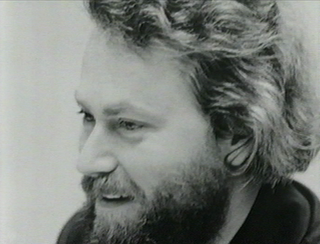
Donald Clarence Judd was an American artist associated with minimalism. In his work, Judd sought autonomy and clarity for the constructed object and the space created by it, ultimately achieving a rigorously democratic presentation without compositional hierarchy. He is generally considered the leading international exponent of "minimalism", and its most important theoretician through such writings as "Specific Objects" (1964). Judd voiced his unorthodox perception of minimalism in Arts Yearbook 8, where he says, "The new three dimensional work doesn't constitute a movement, school, or style. The common aspects are too general and too little common to define a movement. The differences are greater than the similarities."

Robert Walter Irwin was an American installation artist who explored perception and the conditional in art, often through site-specific, architectural interventions that alter the physical, sensory and temporal experience of space.

Dia Art Foundation is a nonprofit organization that initiates, supports, presents, and preserves art projects. It was established in 1974 by Philippa de Menil, the daughter of Houston arts patron Dominique de Menil and an heiress to the Schlumberger oil exploration fortune; art dealer Heiner Friedrich, Philippa's husband; and Helen Winkler, a Houston art historian. Dia provides support to projects "whose nature or scale would preclude other funding sources."
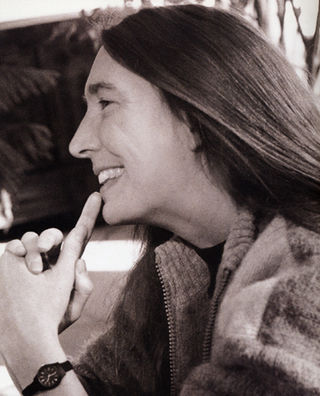
Jenny Holzer is an American neo-conceptual artist, based in Hoosick, New York. The main focus of her work is the delivery of words and ideas in public spaces and includes large-scale installations, advertising billboards, projections on buildings and other structures, and illuminated electronic displays.
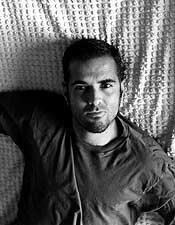
Félix González-Torres or Felix Gonzalez-Torres was a Cuban-born American visual artist. He lived and worked primarily in New York City between 1979 and 1995 after attending university in Puerto Rico. González-Torres’s practice incorporates a minimalist visual vocabulary and certain artworks that are composed of everyday materials such as strings of light bulbs, paired wall clocks, stacks of paper, and individually wrapped candies. González-Torres is known for having made significant contributions to the field of conceptual art in the 1980s and 1990s. His practice continues to influence and be influenced by present-day cultural discourses. González-Torres died in Miami in 1996 from AIDS-related illness.

Robert Ryman was an American painter identified with the movements of monochrome painting, minimalism, and conceptual art. He was best known for abstract, white-on-white paintings. He lived and worked in New York City.

Dia Beacon is the museum for the Dia Art Foundation's collection of art from the 1960s to the present and is one of the 12 locations and sites they manage. The museum, which opened in 2003, is situated near the banks of the Hudson River in Beacon, New York. Dia Beacon's facility, the Riggio Galleries, is a former Nabisco box-printing facility that was renovated by Dia with artist Robert Irwin and architects Alan Koch, Lyn Rice, Galia Solomonoff, and Linda Taalman, then of OpenOffice. Along with Dia's permanent collection, Dia Beacon also presents temporary exhibitions, as well as public programs designed to complement the collection and exhibitions, including monthly Gallery Talks, Merce Cunningham Dance Company Events, Community Free Days for neighboring counties, and an education program that serves area students at all levels. With 160,000 square feet (15,000 m2), it is one of the largest exhibition spaces in the country for modern and contemporary art.

The Chinati Foundation/La Fundación Chinati is a contemporary art museum located in Marfa, Texas, and based upon the ideas of its founder, artist Donald Judd.
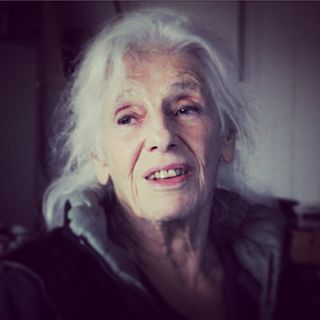
Josephine Gail Baer is an American painter associated with minimalist art. She began exhibiting her work at the Fischbach Gallery, New York, and other venues for contemporary art in the mid-1960s. In the mid-1970s, she turned away from non-objective painting. Since then, Baer has fused images, symbols, words, and phrases in a non-narrative manner, a mode of expression she once termed "radical figuration." She lives and works in Amsterdam, Netherlands.
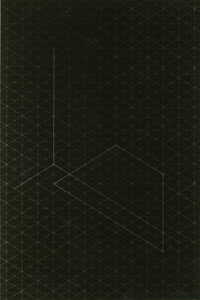
Fred Sandback was an American minimalist conceptual-based sculptor known for his yarn sculptures, drawings, and prints. His estate is represented by David Zwirner.
Diana Thater is an American artist, curator, writer, and educator. She has been a pioneering creator of film, video, and installation art since the early 1990s. She lives and works in Los Angeles, California.

The Kunstmuseum Basel houses the oldest public art collection in the world and is generally considered to be the most important museum of art in Switzerland. It is listed as a Swiss heritage site of national significance.
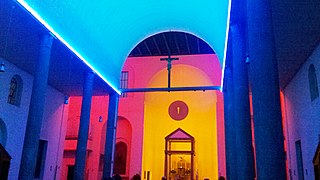
Santa Maria Annunciata in Chiesa Rossa is a church in Milan, via Neera 24.
Stuck Red and Stuck Blue are a pair of art installations produced by the American artist James Turrell. The pieces were created in 1970, and have formed part of several exhibitions of contemporary art in museums around the world, most recently in the Museum of Contemporary Art in San Diego, United States. On each occasion, the pair have been displayed together as a combined installation.

Dia Bridgehampton is a museum in Bridgehampton, New York run by the Dia Art Foundation. Opened in 1983 as the Dan Flavin Art Institute, the building was renovated by Dia, under the direction of minimalist sculptor Dan Flavin, as a permanent display of his fluorescent light works in a single-artist museum. The museum also houses a gallery for temporary exhibitions, and a display of historic objects related to the building from before it became a museum.

Dia Chelsea is an art museum in the Chelsea neighborhood of New York City and is operated by Dia Art Foundation. Opened in 1987 at 548 West 22nd Street as the Dia Center for the Arts, Dia Chelsea has since moved across the street to a series of connected buildings now consolidated at 537 West 22nd Street. It is one of the locations and sites the Dia Art Foundation manages. The Museum hosts longterm but temporary exhibitions dedicated to one or two artists at a time as well as associated artistic and educational programing.
















